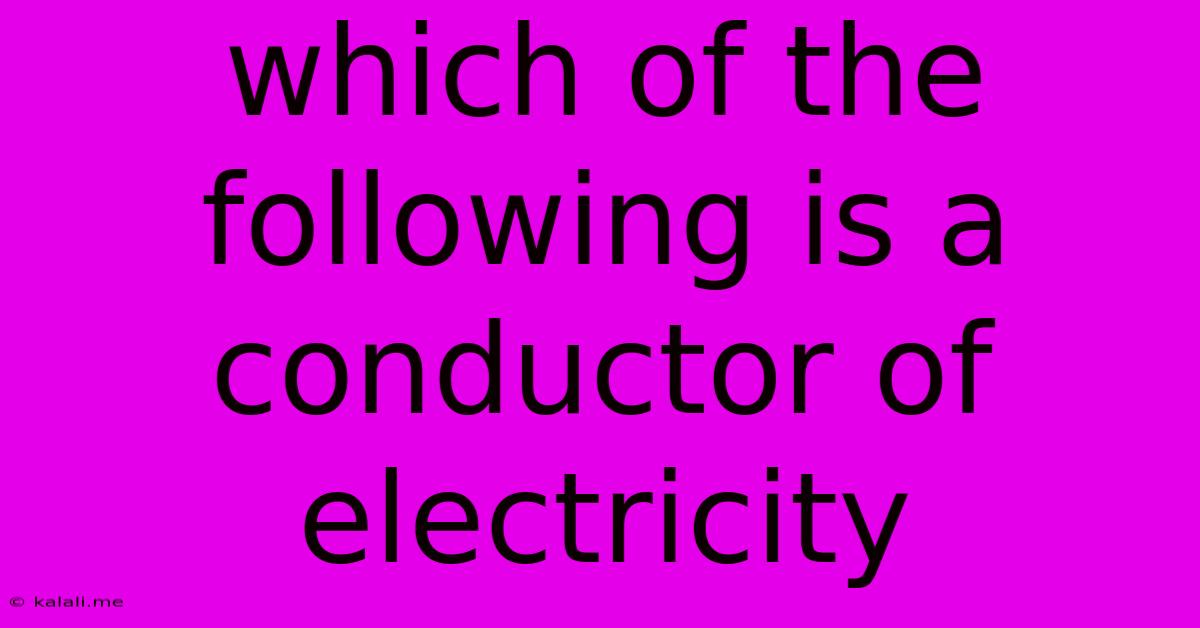Which Of The Following Is A Conductor Of Electricity
Kalali
Jun 12, 2025 · 3 min read

Table of Contents
Which of the Following is a Conductor of Electricity? Understanding Electrical Conductivity
This article will explore the concept of electrical conductivity and help you understand which materials are good conductors and which are not. We'll delve into the science behind it, look at examples, and even discuss some surprising conductors you might not expect. Understanding electrical conductivity is crucial in various fields, from electrical engineering to everyday life.
What is Electrical Conductivity?
Electrical conductivity refers to a material's ability to allow the flow of electric current. This flow is facilitated by the movement of electrically charged particles, primarily electrons. Materials with high electrical conductivity are called conductors, while those that resist the flow of current are called insulators. The conductivity of a material depends on its atomic structure and the availability of free electrons.
Metals: The Champions of Conductivity
Metals are renowned for their excellent electrical conductivity. This is due to their unique atomic structure. In metals, the outermost electrons are loosely bound to their atoms, forming a "sea" of free electrons that can easily move under the influence of an electric field. This explains why materials like copper, aluminum, silver, and gold are widely used in electrical wiring and circuitry. These metals offer a low resistance pathway for electrons to flow, minimizing energy loss.
Other Conductors: Beyond Metals
While metals are the most common conductors, several other materials also exhibit significant conductivity:
- Graphite: A form of carbon, graphite possesses excellent conductivity due to its layered structure, allowing for electron mobility between layers. This property makes it useful in battery electrodes and other electrical applications.
- Electrolyte Solutions: Solutions containing dissolved ions (charged atoms or molecules) can conduct electricity. This is because the ions can move freely and carry charge. Examples include saltwater, acid solutions, and base solutions.
- Plasma: Plasma is an ionized gas, meaning its atoms have been stripped of some of their electrons, resulting in free electrons and positively charged ions. This makes plasma a highly conductive medium.
Insulators: Blocking the Flow
In contrast to conductors, insulators resist the flow of electric current. This is because their electrons are tightly bound to their atoms, making it difficult for them to move freely. Common insulators include:
- Rubber: Used extensively in electrical insulation for its high resistance.
- Plastic: Various plastics like PVC and Teflon are excellent insulators.
- Glass: A non-conductive material used in many electrical applications.
- Wood: Generally a poor conductor of electricity.
Identifying Conductors: A Simple Test
A simple way to determine if a material is a conductor is to use a simple circuit with a battery, a bulb, and wires. If the bulb lights up when the material is placed in the circuit, it indicates that the material is a conductor. However, be cautious when performing this test, as some materials might conduct electricity at dangerous levels.
Conclusion:
Understanding which materials conduct electricity is fundamental to many aspects of science and technology. While metals are the most common and effective conductors, several other materials, including graphite, electrolyte solutions, and plasma, also exhibit significant conductivity. Conversely, insulators effectively block the flow of electricity, playing a critical role in safety and electrical system design. By understanding the properties of conductors and insulators, we can design and utilize electrical systems safely and efficiently.
Latest Posts
Latest Posts
-
Single Entry Vs Double Entry System
Jun 13, 2025
-
Which Of The Following Is A Rational Number
Jun 13, 2025
-
Which Of The Following Components Converts Ac To Dc
Jun 13, 2025
-
The Middle Letter Of The Alphabet
Jun 13, 2025
-
The Expanded Ends Of A Long Bone Are Called The
Jun 13, 2025
Related Post
Thank you for visiting our website which covers about Which Of The Following Is A Conductor Of Electricity . We hope the information provided has been useful to you. Feel free to contact us if you have any questions or need further assistance. See you next time and don't miss to bookmark.